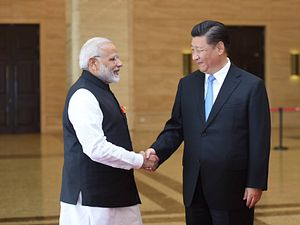This past weekend, military officers from India and China met at Moldo, along the Line of Actual Control, for what would be the fifth round of disengagement talks over the course of this summer’s seemingly intractable standoff. The good news is that, in the aftermath of the surprising June 15 altercation that resulted in the deaths of 20 Indian soldiers and unknown Chinese casualties, both sides have managed to avoid further escalation.
The bad news — especially if you’re India — is that a return to the status quo ante of April 2020 appears increasingly remote. The latest round of talks was meant to result in a “time-bound and verifiable” disengagement, but this doesn’t appear to be possible in the current environment.
While the situation has broadly cooled off in the Galwan Valley, the locus of the June 15 clash and the focus of most coverage of the ongoing standoff, the People’s Liberation Army remains dug into its forward positions along its claim line in Pangong Tso and maintains its positions at contested patrol points in the Gogra-Hot Springs area. The Indian Army also has to contend with the PLA’s continued presence in the Depsang plains.
As I wrote last month, I remain convinced that this standoff is unlikely to be soon resolved in a comprehensive manner. As I wrote for Datayo, the background factors leading to this crisis — factors that really trace their origins back to the 2017 Doklam standoff — remain prominent. This week, one of these factors — India’s administrative reorganization of the former state of Jammu and Kashmir into two new Union Territories — once again reared its head.
Wednesday marked the one-year anniversary of Indian Home Minister Amit Shah’s announcement to the Indian parliament that the ruling Bharatiya Janata Party government in India would follow through on one of its long-stated promises: abrogating parts of Article 370 of the Indian constitution to end certain autonomous provisions for the state of Jammu and Kashmir and, additionally, bifurcate Kashmir into the centrally governed Union Territories of Jammu and Kashmir (bearing the same name as the old state) and Ladakh.
One day after the Indian announcement, the Chinese Foreign Ministry had released a statement noting that “India has continued to undermine China’s territorial sovereignty by unilaterally changing its domestic law.” This Wednesday, responding to a question on the one-year anniversary of the Indian decision, Wang Wenbin, an official spokesperson for the Chinese Foreign Ministry, responded that “China follows closely the situation in the Kashmir region.”
“Our position is consistent and clear. This issue is a dispute left over from history between Pakistan and India. That is an objective fact established by the U.N. Charter, U.N. Security Council resolutions and bilateral agreements between Pakistan and India. Any unilateral change to the status quo is illegal and invalid,” Wang added. Ladakh, the Indian union territory abutting Aksai Chin, where the Line of Actual Control (LAC) runs, was not specifically mentioned, however.
One year on, it’s clear that the scope of India-China differences has considerably broadened and while there were other factors that likely sparked this year’s standoff, including Indian infrastructure activity in proximity to the LAC, the Modi government’s Article 370 and bifurcation decisions contributed an important background factor to this year’s standoff.

































